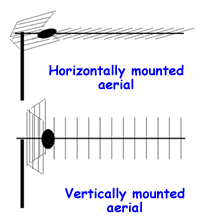|
Polarisation - Directional Antennae  We live in a world of communication signals. There is a very high density of radio and microwave electromagnetic wave signals transmitted all of the time in our city areas. In order for us to pick up signals we have to have them transmitted at a particular frequencies or wavelengths and then have our receivers tuned to the particular frequency of the signal we wish to recieve.
As the radio signals travel out from the antenna the signal gets weaker because of the effect of its spreading out (invese square law) and absorption by objects in its path (attenuation). Multiple broadcasting stations therefore have to be set up - transmitting the same program on the same frequency. You only want to pick up the signal from one transmitter - otherwise you would have interference between the two. Even though they travel at almost the speed of light they would be very slightly 'out' with each other. So how can we pick up only the signal from one transmitter? This is done by polarisation. The signals from the two stations in our vicinity braocdcast at the same frequency but the signal is polarised in a differeent orientation. The receiver aerial or dish is orientated to pick up the strongest of the signals and to diminish the weaker one. Practically this is done by rotating it and testing for the position that gives the best signal - this is usually done by the installer as it often involves getting up on the roof. See the vidclip below for a lab demonstration.
|
Follow me...
|


 Using polarisated transmission and reception makes it possible to mazimise the use of the 'airwaves'. We can license two different sellers of information to use a particular radio or microwave frequency and have the signals polarised perpendicular to each other when the are transmitted. The recievers can then pick up the signal they want by having their receiving aerial or antenna correctly orientated.
Using polarisated transmission and reception makes it possible to mazimise the use of the 'airwaves'. We can license two different sellers of information to use a particular radio or microwave frequency and have the signals polarised perpendicular to each other when the are transmitted. The recievers can then pick up the signal they want by having their receiving aerial or antenna correctly orientated. 


